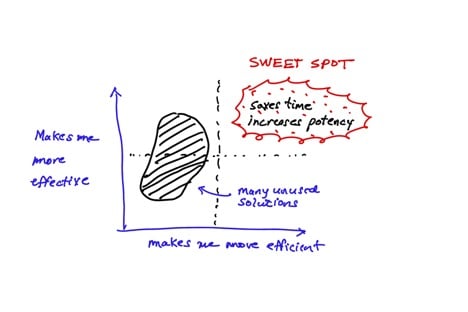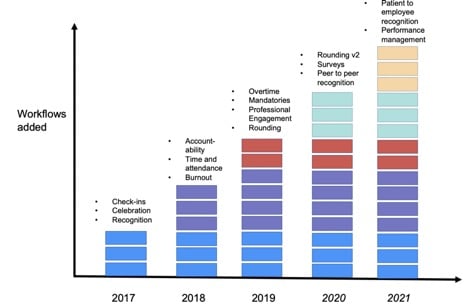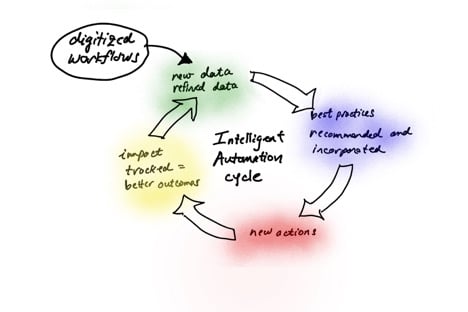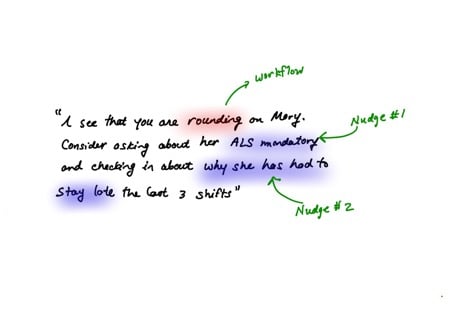There is a management gap in healthcare. It can be partially solved by an interconnected system that has integrated employee profiles from multiple data sources. These profiles can be used to predict who is at risk and to suggest the next-best management action. This massively scales the impact of the manager and gives them the tools to make large teams feel small, while they are assisted by predictive analytics and machine learning. But that’s still not enough to close the gap.
The Sweet Spot
The reason is usage. The healthcare landscape is littered with tools that senior executives thought managers would use but they end up collecting dust as “yet another login I never use”. Managers are busy and their time is already over-subscribed, so the bar is high. Our research has proven that most of the time managers will not use a new tool unless it both saves them time and makes them more effective. That’s the sweet spot.

Digitized Workflows Ensure Usage
Laudio’s answer to this challenge is to build digitized workflows. Workflows are the tasks that managers are responsible for every day. Once we are embedded in a workflow, we know that our solutions will be heavily utilized. Examples of these workflows for every manager are rounding, time and attendance, and performance management. Most of these workflows are done manually, every day, without the benefits of a shared database or intelligent automation. The reason that these workflows are done manually is that they are not easily automated because the required data lives in disparate databases. Laudio has done the hard work of building the piping to get the data into one place. Once we do that, we can create solutions that intelligently automate what was previously manual and tedious.

One good example, of the many workflows that Laudio digitizes, is employee rounding. Employee rounding is a difficult thing to do when a manager has 60 direct reports, these reports are all on different schedules and shifts, and the data from the rounds go into a data silo. In most organizations, employee rounding has devolved into a Pro-forma conversation between manager and employee that checks-the-box but is not all that helpful. And only a few managers can keep on top of the process since it requires an in-person interaction in the context of protean schedules and all of the other things a manager does. However, in the time of COVID-19, suddenly employee rounding became essential. How are our teams reacting to the environment, to the risks, to all the changes? The only way to get that information (in an accurate and timely manner) was by rounding and recording the results.
Intelligent Automation Is Now Possible
Laudio can provide intelligent automation to the process. We accomplished this by integrating the time and attendance, HRIS, and manager databases, and providing the manager a dynamic schedule of rounding based on their own goals, the last completed round, and employee risk. We were able to go a step further by supporting the manager to email each employee the day before the round with a dynamic list of questions to consider in advance. The content of these questions rotates based on the needs of the manager, and the organization. Rounds suddenly became a whole lot more useful and more consistent even, essential. Also, this all feeds into the ever-reinforcing cycle of intelligent automation.

By digitizing the rounds, we saved the managers’ time. Because of this, their usage of the tool increased. They incorporated new best practices and made thousands of incremental management actions. Rounding became a classic win-win. But the real benefit is that once the managers embraced the new rounding tools and processes, Laudio was able to use nudges to further optimize management actions.
Influencing Behavior with “Nudges”
According to Wikipedia, “nudge is a concept in behavioral economics, political theory, and behavioral sciences which proposes positive reinforcement and indirect suggestions as ways to influence the behavior and decision making of groups or individuals.”
Laudio has designed our nudges to appear inside manager workflows. While a manager is doing team rounding, we can nudge that manager to reach out to a certain employee in a certain way at a certain time. This means that managers receive intelligent automation in the line of their existing work — no separate login, no need to cross-reference tools and screens. This is a powerful concept that allows us to stimulate managers to take thousands of positive, reinforcing actions that they would otherwise have not done.

We have nudges designed to support managers inside many workflows: performance management, accountability, surveys, reviews, mandatories, time and attendance, and the list goes on. We hope that, in this way, we can vastly improve the power of the manager while saving them time. And this results in better work, employee wellness, engagement, and loyalty. How do we manage all these nudges? We push them in a feed, within the workflows. And that is the topic of my next blog post.